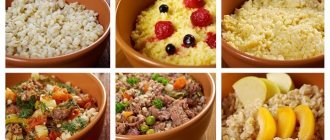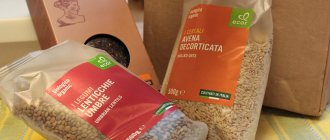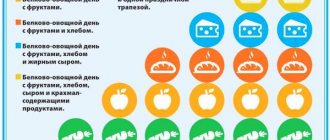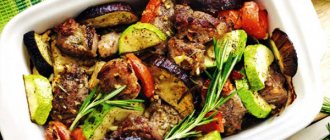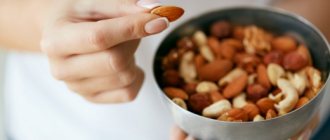“Without porridge, lunch is not lunch,” “Porridge is our nurse,” “Without porridge, our labors are worthless”—the Russian people have long had a special attitude towards this dish. Nowadays, for breakfast, it is increasingly being replaced with yoghurts, cottage cheeses, and even buns and sandwiches as a snack with coffee. They remember about it only when they start organizing proper nutrition or when it’s time to lose weight. But here the question arises: which cereal should I prefer so that there are more health benefits and the extra pounds go away faster?
About low-calorie
Low-calorie cereals
Experts call low-calorie foods those whose calorie content per 100 g of weight does not exceed 100 kcal. From this point of view, there is no such thing as “dietary cereal”, because in dry form they all “weigh” 250 kcal and more. Therefore, we can highlight only those with the lowest indicator compared to others. Although the values of many of them are very close to each other.
Here and on many websites, the calorie content of dry cereal is given approximately. For example, for semolina, one online calorizer gives 335 kcal, another - 328, a third - 322. Just for fun, you can look at packaging from different manufacturers: Makfa semolina - 333 kcal, Eurozlak - 325, Uvelka - 350. And so with all products this food category. The fact is that this indicator depends on many factors: what grain was taken as a basis (soft or hard varieties, whole or pre-ground), what kind of processing the raw materials underwent, and the characteristics of the additives.
Low-calorie porridge
Compared to cereals, their calorie content is 2-3 times less. This happens for two reasons. Firstly, the weight changes during cooking: from 1 cup of dry raw material, we get as many as 3 cups due to the addition of water (milk) and the swelling of natural fiber. Secondly, during heat treatment, fats and other nutrients are evaporated, which essentially constitute the calorie content of any product.
As a result of all these processes, some porridges still turn out to be low-calorie, falling within the framework of 100 kcal per 100 g of ready-made dish. However, here the indicators will be quite conditional. Semolina from Eurozlak will make a lighter breakfast than if you use a product from.
Recommendations
On the one hand, nutritionists recommend consuming as many vegetables as possible during the cold season, as they are sources of vitamins. On the other hand, they are much more useful during the season.
Raw vegetables contain many beneficial substances, but can lead to intestinal disorders. Therefore, alternate them with heat-treated ones: stewed, boiled, steamed, baked, but not fried. Keep in mind that heat treatment changes the calorie content of the dish. It may become larger or smaller.
Vegetable dishes go well with lean fish and meats, herbs, spices and lemon juice.
To jumpstart your metabolism and minimize the risk of intestinal disorders, drink up to 2 liters of water daily - this is essential if you consume a lot of fiber.
Rinse everything thoroughly. There should be no rot or mold. Even if you cut off the bad side, harmful substances may have already spread into the pulp or peel. The result is an eating disorder and gastric lavage instead of weight loss.
Learn to eat vegetable dishes without salt - significantly improve your weight loss results. As a last resort, use the sea one.
Lifehack. The smaller the chili pepper, the hotter it is.
About supplements
When selecting cereals for your breakfast, be sure to take into account the additives that will improve their taste. They can significantly change the indicator you need. Judge for yourself (approximate values):
- ½ tsp. cinnamon = 10 kcal;
- 1 tsp. honey = 25 kcal;
- 1 tsp. granulated sugar = 32 kcal;
- 1 tsp. raisins = 13.5 kcal;
- 1 tsp. olive oil = 89.8 kcal;
- 1 tbsp. l. chopped walnuts = 47 kcal;
- 1 tbsp. l. strawberries = 8 kcal, raspberries = 9 kcal, cranberries = 6 kcal;
- 1 tbsp. l. strawberry jam = 57 kcal, raspberry jam = 54 kcal, cherry jam = 51 kcal;
- 10 g butter = 74.8 kcal;
- 20 g of cheese = 52 kcal;
- 50 g bananas = 49 kcal, apples and cherries = 26 kcal, pears = 23 kcal;
- 50 g low-fat cottage cheese = 42 kcal;
- 100 ml of milk: 1% = 40 kcal, 2% = 45 kcal, 2.5% = 52 kcal, 3% = 58 kcal.
It’s not hard to guess that even the lowest-calorie porridge will cease to be so if you cook it in full-fat milk and add sugar, butter, nuts and fruits. For weight loss, this risks going beyond the daily caloric intake and weight gain rather than weight loss. The most dietary one will be the one cooked in water and without any additives. Yes, eating it will not be entirely pleasant, but the benefits for the body and figure will be beyond any doubt.
As for salt, it does not affect the calorie content of dishes in any way. However, it should not be abused. Its daily intake is significantly limited in the proper nutrition system, in treatment tables, and in weight loss diets. The reason is that it retains water in the tissues, disrupts the water-salt balance, and negatively affects kidney function.
How much weight can you lose on a buckwheat diet in 14 days?
If you adhere to a strict buckwheat diet and do not eat any other foods, then in 14 days you can lose 12 kg of excess weight. This will not harm your health and will allow you not to feel hungry.
You need to eat according to a schedule. Weight will decrease even after leaving the diet, if you do not indulge in high-calorie foods and do not overeat. In addition to the fact that in 14 days you can get rid of a fairly impressive amount of excess fat, you will also be able to improve your body’s health. Of course, you can extend the diet from 14 to 30 days. During this time you will be able to lose a lot of weight. However, such a prolonged diet can have a negative impact on health.
Low-calorie cereals with calories indicated
In fact, the choice of cereals that we can prepare is not so large, since the range of cereals available to us in stores is limited. Therefore, we provide data for all the most popular ones.
The table is built taking into account the increasing calorie content of porridges cooked in water, since they are the lowest in calories. Indicators for dairy products are based on 1.5% milk fat content.
The figures are given without taking into account any additives. Only cereal and water or milk. All other ingredients that you use will add to the indicated calorie content.
Explanations:
- If the calorie content of varieties of the same cereal in dry form differs significantly (compare whole grain oats and rolled oats), then for porridges this difference is practically erased, because evaporation occurs approximately the same.
- Boiling of cereals in water and milk occurs differently. This explains why the lowest-calorie porridge made with water is barley porridge, and rice porridge made with milk.
Advantages and disadvantages
The porridge diet has the following advantages:
- cereals contain many elements beneficial to the human body;
- are easily digestible and go well with berries, fruits, vegetables, and meat;
- cereals do not contain preservatives;
- Porridges can be purchased at the grocery store, they are cheap and easy to prepare.
The big disadvantage of such weight loss is the leanness of the dishes. Porridges prepared for dietary nutrition should not contain flavoring additives, that is, neither salt nor sugar. Dietary foods based on cereals have their contraindications. This diet should not be used if you have the following symptoms:
- increased glucose levels;
- exacerbation of diseases of the stomach and duodenum;
- pregnancy;
- lactation.
During any dietary regimen, you should not drink alcoholic beverages! Alcohol gives the body artificial energy, thereby preventing the body from breaking down fatty tissue.
There are hundreds of porridge recipes that will burn fat, help you diversify your menu and enjoy your diet.
Ratings
Based on the table above, it is easy to make ratings of the lowest-calorie cereals and cereals. But remember that they will be conditional. The values are as close as possible to each other and can change places in such a TOP.
For example, according to generally accepted standards, corn grits are higher than semolina (328 kcal versus 333). But it “weighs” 360 kcal, and semolina from Makfa weighs 333 kcal. So watch the packaging you buy.
Rating of water-based porridges by calorie content (hereinafter - from lowest to highest):
- Barley.
- Rice.
- Manna
- Corn
- Oatmeal.
- Pea.
- Millet
- Buckwheat.
- Spelled
- Wheat
Almost all dishes included in this TOP 10, with the exception of the last position, can rightfully be called low-calorie, since they fit within the framework of less than 100 kcal per 100 g of a ready-made dish.
Rating of cereals with milk by calorie content:
- Rice.
- Manna.
- Oatmeal.
- Barley.
- Corn.
- Millet.
- Spelled
- Wheat.
- Pearl barley.
- Buckwheat.
Here, in terms of low-calorie content, it is already much more difficult than with water options. Only the first 2 fall into the range of less than 100 kcal per 100 g of ready-made food. For the rest, this figure exceeds the established value.
Rating of dry cereals by calorie content:
- Oats (whole grain).
- Dried peas.
- Barley grits.
- Buckwheat is ordinary.
- Pearl barley.
- Corn grits.
- Semolina.
- Millet.
- Spelled
- Rice (buryts)
As already mentioned, none of the cereals falls into the low-calorie category from a nutritional point of view. However, this is not so critical, since no one will eat them dry. And after boiling, this figure becomes several times less.
The right way out of the porridge diet
When the diet is completed, it is necessary to gradually exit it so that the body does not get stressed. It is necessary to gradually introduce those products that were not in the above menu. But remember that you should start with small portions, gradually increasing the amount of products:
- vegetable soups, hard-boiled or soft-boiled eggs;
- boiled chicken meat, kefir with a minimum percentage of fat content;
- homemade cottage cheese, fresh fruit;
- hard cheese, slightly dried bread.
If you do everything gradually and carefully, you can return to your usual diet. Your body will receive sufficient amounts of microelements and vitamins for the stable functioning of all organ systems.
Leaders
On the water
The lowest calorie porridge on water is barley (76 kcal).
What is it prepared from: from barley groats (cells), and this, in turn, is made from crushed barley.
Compound:
- calcium, potassium, phosphorus, iron, iodine, bromine, manganese, zinc, sulfur, molybdenum;
- niacin, ergocalciferol, tocopherol, thiamine, folic acid;
- complex carbohydrates, plenty of protein and fiber.
Benefit:
- cleanses the intestines;
- improves digestion;
- promotes weight loss;
- has a diuretic effect;
- indicated for diabetes and gastritis;
- supplies energy for the whole day;
- guarantees long-lasting and lasting saturation.
Proportions and cooking time:
- for crumbly porridge: for 1 cup of egg - 2 cups of water, cook for 15 minutes;
- for thick and viscous: 1 to 4, cook for 25 minutes;
- for semi-viscous (used in medical nutrition): 1 to 3, cook for half an hour.
It is better to pre-soak the cell in cold water for a couple of hours.
With milk
The lowest calorie porridge with milk is rice (97 kcal).
What is it made from: white or brown rice.
Compound:
- almost all B vitamins, especially a lot of thiamine, riboflavin and niacin, as well as tocopherol and phylloquinone;
- sodium, potassium;
- complex carbohydrates, protein, fiber.
Benefit:
- has an enveloping therapeutic effect on the stomach, indicated for any problems with the gastrointestinal tract;
- promotes weight loss;
- relieves swelling;
- improves blood composition;
- has a calming effect on the nervous system;
- normalizes blood pressure.
Proportions:
- as in kindergarten: for 1 glass of rice - 1 glass of water and 1 liter of milk;
- liquid: for ¾ cup of rice - 1 cup of water and 2 cups of milk;
- thick: for 1 cup of rice - 2 cups of milk.
Do not forget that you have a low-calorie dish, which means that milk should have no more than 1.5% fat content. Cooking time: 30 minutes. Pre-soaking the rice is not required. But it is necessary to rinse it in running cold water.
Groats
The lowest calorie cereal of all is whole grain oats (250 kcal).
Compound:
- retinol equivalent, riboflavin, thiamine, ascorbic, pantothenic and folic acids, niacin, tocopherol, choline, pyridoxine, biotin;
- potassium, calcium, phosphorus, magnesium, sodium, iron, selenium, fluorine, silicon, iodine, zinc, copper, sulfur, chromium, manganese;
- amino acids;
- fiber, complex carbohydrates, protein.
Benefit:
- improves digestion;
- cleanses the intestines;
- prevents the breakdown of muscle fibers;
- speeds up metabolism;
- lowers cholesterol
- promotes long-term saturation;
- improves brain activity;
- suppresses cravings for sweets.
Proportions: per 100 g of whole grain oatmeal - 500 ml of water. Cook for 30-40 minutes.
Barley
What are the benefits of barley groats? A distinctive feature of barley is its high amount of fiber, so this cereal is often recommended for people with impaired gastrointestinal tract function. It helps slow down the rise in blood sugar and is beneficial for obesity. Barley helps cleanse the body of impurities, and in return it is ready to offer many useful elements - phosphorus, which it is especially rich in, silicon, copper, iron, selenium and much more.
Calories: 324 Protein: 10 Fat: 1.3 Carbohydrates: 71.7
| [:product:cher0007:] | [:product:cher0008:] | [:product:ariv0002:] |
Here are a few more dietary cereals that are not so easy to find on store shelves, but which are so beneficial for our body.
Instant cooking
Nowadays, instant porridges (ready-made, instant, brewed), which are sold in portioned bags, are quite popular. The dry contents are poured with boiling water, infused for literally 5-10 minutes and breakfast is ready. Moreover, many manufacturers put the “low-calorie” mark on such products. But are they actually dietary?
The average calorie content of ready-made porridges is 350 kcal per 100 g of dry product. For 1 serving you need from 20 g (1 tbsp.) to 60 g (3 tbsp.). This means that it will “weigh” from 70 to 175 kcal, depending on the total calorie content and serving size. At the same time, it will really be low-calorie in any case, because the dry raw material is filled with 150-200 ml of water - you get a full plate of the dish for breakfast, and even fit into 175 kcal. But there are also additives in the form of fruits, honey, and nuts.
Everything would be ideal, but... Dieticians and nutritionists categorically do not recommend eating instant cereals for breakfast, no matter how low-calorie they are. There are good reasons for this:
- cereals are processed at high temperatures, and nothing of the beneficial substances remains in them (except for tocopherol and some B vitamins, which are not afraid of this);
- contain a large amount of starch (promotes rapid swelling), which leads to diabetes and excess weight;
- Instead of natural fruits and berries, dried fruits treated with chemicals are often used.
So instant porridge is both low in calories and harmful to health at the same time. Only you can choose what is more important to you.
A short overview of brands for reference:
Similar dietary porridges are produced in ready-made form by other brands:
- Vasteko - with spelled;
- Divinka's fitness lunch - “5 grains” with fructose;
- Vita - “Live porridge” from oats, rye, barley, wheat;
- The power of Altai is cedar, pumpkin, flax;
- FitParad - flaxseed, oatmeal;
- Health compass - flax, hemp, cedar;
- Racionika diet - buckwheat-flaxseed.
Cereals for weight loss
Each type of cereal has a unique set of properties and effects on the body. The usefulness of cereals for weight loss is determined by a number of criteria. The main ones are the low glycemic index (GI), the variety of macro- and microelements included in the composition, the presence of amino acids and vitamins, especially group B.
Buckwheat grain.
Contains a huge amount of slow carbohydrates, thanks to which it saturates well with energy for sports and satisfies hunger for a long time. It also contains a lot of protein, which is necessary for maintaining muscle mass.
Oat groats.
Rich in fiber and microelements. Gives a lot of energy, so it's great for breakfast! Oatmeal envelops the gastrointestinal tract with a special film, protecting them from inflammation. It also cleanses the intestines well and improves overall well-being.
Millet cereal.
It rids the body of toxins and excess fluid, which helps normalize metabolic processes. Effectively blocks hunger. It also strengthens the immune system and resistance to diseases thanks to a large number of beneficial microelements.
Pearl barley.
A very satisfying dish with low calorie content. Even a small portion of this porridge is enough to satisfy your hunger for a long time. The antioxidants included in the composition improve the condition of the skin and hair. Barley cleanses the intestines well and prevents constipation.
Corn grits.
Protects the body from infections and inflammation, accelerates wound healing and strengthens blood vessels. Contains a large amount of fiber, complex carbohydrates, saturated fatty acids and amino acids, which helps to quickly lose weight.
When choosing porridge for weight loss, trust only reliable and trusted manufacturers. Another rule is that it is better to consume cereals in the morning or at lunch. And by replacing the first meal with a balanced Herbalife breakfast, you can make weight loss even more effective and support the body with useful substances during the diet. This product is low in calories, but provides a feeling of fullness for several hours, and also gives energy and replenishes macro- and micronutrients. All this is important for those who want to keep their weight under control.
Useful tips
- Such a healthy breakfast will provide the body with fiber. But for it to work, you need to drink a lot of water.
- It is also a source of complex, but still carbohydrates. So that they do not go into fat, but into useful energy, you need to be active and play sports.
- The simplest and lowest calorie recipe: water + cereal without salt or any additives.
- The recommended serving size for breakfast when losing weight is 200 g, with proper nutrition - 250 g.
- Each cereal has a separate list of contraindications that must be observed.
- Don’t be lazy and take the time to cook with your own hands instead of buying bright but useless tea bags.
- Every morning you should have a new porridge for breakfast: today - oatmeal, tomorrow - barley, the day after tomorrow - buckwheat.
Flax seeds as an alternative to cereals
In Europe, flax seeds are very popular. They are produced under the “superfood” brand and added to various dishes. The main advantage of flax seeds is their high protein content - 28.9 g. At the same time, they contain a minimum of carbohydrates (17 g) and fat (11 g). Another value of the product is omega-3, the amount of which is 10 times greater than in buckwheat. Flax seeds are also rich in B vitamins and fiber (about 40%).
Oven-roasted vegetables
Vegetables can simply be baked whole. And if you do a little magic at the stove, you will get real baked vegetable masterpieces. Original and very useful. Here are some of them.
Recipe for baked vegetables with mushrooms
- eggplant – 1 piece, large;
- zucchini – 1 piece, medium;
- sweet pepper – 2 pcs.;
- onion – 1 pc.;
- champignons – 5-6 pcs.;
- tomatoes – 2 pcs.;
- garlic – 2 cloves.
1Cut the eggplants into cubes, add salt and let stand for 30 minutes. to remove bitterness.
2Cut the remaining vegetables into arbitrary medium pieces.
3 Cut the mushrooms into 4 parts.
4Cover a deep dish with baking foil so that it protrudes sufficiently beyond its edges.
5Place the vegetables in a mold, add salt, add chopped garlic and cover with foil.
6Bake at 200 degrees for about 1 hour. Then open the foil, sprinkle with olive oil if desired and leave in the oven for another 15 minutes to form a beautiful golden brown crust.
Contraindications
- pathology of the digestive tract;
- eczema , psoriasis and other skin diseases (high risk of exacerbations due to diet);
- allergic responses;
- pancreatic diseases;
- increased blood clotting ;
- intestinal diseases.
If you are diagnosed with diabetes, it is recommended to exclude hazelnuts from your diet.
For tachycardia , almonds are contraindicated.
In people with a history of excess weight gain, a nut diet can cause obesity and an increase in liver size.
